April 13, 2025 | 20:29 GMT +7
April 13, 2025 | 20:29 GMT +7
Hotline: 0913.378.918
April 13, 2025 | 20:29 GMT +7
Hotline: 0913.378.918
Vietnamese durian is predominantly produced in southern provinces, from Da Nang city onwards, and in a province belonging to the North Central Coast, namely Thua Thien - Hue. The durian production area in Vietnam was relatively small ten years prior, with the primary purpose of serving the domestic market.
However, the durian production area in Vietnam has rapidly expanded over the years to house a major fruit crop with significant economic value. According to statistics from the General Department of Customs, Vietnamese durian has been recognized as a billion-dollar crop in 2023 due to its considerable export value, reaching 1 million tons by September 2023 and an export value of 1.63 billion USD.
The strong growth of durian in Vietnam has led to the formation of distinct production areas with varying harvesting seasons due to the differing climatic conditions. Competitive durian farmers must possess a thorough understanding of the harvesting seasons in each region to subsequently plan appropriate harvest schedules and secure higher prices.
According to statistics from the Department of Crop Production under Ministry of Agriculture and Rural Development, Vietnam's total durian production area was estimated at 131,000 hectares in 2023, marking an increase of 20% compared to that in 2022. The Central Highlands account for the majority of the total durian production area at 40.4%, followed by the Mekong River Delta at 34.6%, the Southeast at 19.4%, and the South Central Coast at 5.6%. Accordingly, the Central Highlands have surpassed the Mekong River Delta to become the country's largest durian-producing region.
Durian is cultivated in areas of alluvial soil near the freshwater, or non-flooded areas alongside the Tien and Hau rivers within the Mekong River Delta. Primary production areas include Tien Giang province, followed by the provinces of Ben Tre, Vinh Long, Soc Trang, and Can Tho city.
In Tien Giang province, durian production is concentrated in Cai Lay district, renowned for its "Kho qua xanh" durians in Ngu Hiep islet as well as a range of remarkable durian varieties such as "Chuong Bo Hat Lep" and "6 HUU."
To date, the durian production area in Tien Giang province has expanded to cover multiple districts and towns, including Cai Lay, Chau Thanh, and Cai Be. On the other hand, durian production in Ben Tre province is prevalent in Chau Thanh and Cho Lach districts; Binh Hoa Phuoc islet, Long Ho district, and Thanh Binh islet in Vung Liem district in Vinh Long province; Phong Dien district and neighboring areas in Thoi Lai district and O Mon district in Can Tho city; and Ke Sanh district in Soc Trang.
Popular durian varieties in the Mekong River Delta currently include Ri6, Monthong, and to a lesser extent, Milk Yellow Grain, Chuong Bo Hat Lep, and 6 HUU.
Durian farms in the Mekong River Delta often have proactive embankments to manage water, preventing salinity intrusion and flooding, enabling year-round flowering control for the trees. However, in 2016 and 2020, severe saltwater intrusion caused considerable damage to durian cultivation in Cai Lay district in Tien Giang province, Chau Thanh district in Ben Tre province, and Vung Liem district in Vinh Long province.
In Southeastern Vietnam, durian was previously produced along the Saigon River and Dong Nai River, renowned for their fruit trees in Lai Thieu district. Presently, durian is extensively grown in the districts of Long Khanh, Cam My, Dinh Quan, and Tan Phu in Dong Nai province; Go Dau and Loc Ninh in Tay Ninh province; and Phuoc Long in Binh Phuoc province.
Notably, durian production areas in the Southeast region primarily consist of gentle sloping land, with an average elevation of less than 200 meters above sea level. Additionally, these areas rely on water sources from rivers, streams, and especially wells, resulting in water shortages during the dry season. A relatively large and concentrated durian production area belonging to Da Hoai district, Lam Dong province, which is located adjacent to Tan Phu District in Dong Nai Province, covers nearly 5,000 hectares. The durian production area in Da Hoai district features gentle slopes and an elevation of less than 350 meters, sharing many similarities in terms of natural conditions with Tan Phu district, Dong Nai province. Durian is commonly intercropped with coffee, pepper, or other fruit trees such as avocados in Dong Nai province. Farmers in the Southeast region primarily rely on natural conditions for production and apply minimal techniques for controlling off-season flowering.
In the Central Highlands, durian was previously produced in Dak Lak province (including present-day Dak Nong province). Subsequently, the production area was expanded to include the provinces of Gia Lai, Kon Tum at elevations ranging from 500 to 800 meters above sea level and the districts of Bao Loc, Di Linh in Lam Dong province at elevations of 700 to 800 meters above sea level.
The Central Highlands feature the fastest expanding durian production area (at 2.5 times) nationwide over the last three years. The durian production area in the Central Highlands has surpassed that of the Mekong River Delta to become the largest durian production in Vietnam. Newly established durian production areas in the Central Highlands primarily consist of specialized farms, in contrast to the traditional durian and coffee intercropping method. Due to declining coffee prices and increasing durian prices, the latter has received extensive investment and priority to generate higher income. Due to the naturally sloping lands with limited access to water sources in the Central Highlands, durian farmers mainly rely on natural conditions without adopting techniques to control off-season flowering.
Along the Central Coast, durian is predominantly produced in districts bordering the provinces of Lam Dong, Dong Nai and Binh Thuan, such as Ham Thuan Bac, Duc Linh. Notably, the majority of the durian production areas is concentrated in Khanh Son district, Khanh Hoa province. Additionally, durian is also sporadically grown across the provinces of Phu Yen, Quang Ngai, and Quang Nam. Overall, these areas represent the emerging durian production areas within the last few years.
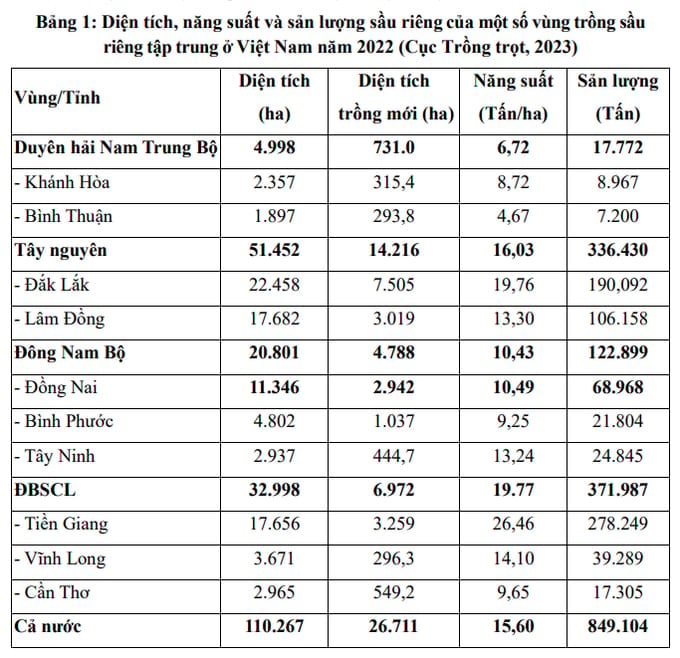
Statistics on production area, productivity, and yield across several major durian production areas in Vietnam in 2022, as provided by the Department of Crop Production under the Ministry of Agriculture and Rural Development. Photo: Kim Anh.
The rapid development of the durian production areas, which surpassed the planned area of 85,000 hectares by the Ministry of Agriculture and Rural Development, has posed numerous challenges to every stakeholder in the durian value chain.
Farmers in newly estalbished production areas lack knowledge of design techniques and branch pruning methods for trees as well as implement unsuitable cultivation practices, leading to delayed fruiting, low productivity, and inadequate pest and disease management techniques which diminish both productivity and fruit quality. Namely, the development of durian production in Vietnam is facing various obstacles, including saline soil and irrigation water scarcity resulting in poor tree development, and high mortality rates causing significant losses for farmers and the community.

A durian farm in the Central Highlands with designs which failed to adhere to technical standards. Durian trees are planted close to the ground, similar to coffee trees, causing waterlogging at the tree base during the rainy season, and exposing them to root diseases. Photo: TVH.
Local agricultural extension officers and agricultural management lack sufficient knowledge about durian cultivation techniques in their respective areas, hindering their ability to adequately support growers. Supplies, fertilizers, and pesticides from companies do not arrive promptly, resulting in suboptimal effectiveness. Scientists have not yet formulated specific regional cultivation procedures for durian, leading to relatively low efficiency. There is a lack of skilled harvest teams, especially during peak harvest times, resulting in subpar fruit quality. The purchasing, packaging, and post-harvest handling facilities are insufficient, causing a decline in the quality of exported fruits and impacting the reputation of Vietnam's durian brand.

Durian trees suffering from dryness and premature fruit dropping due to improper watering techniques, which stem from farmers' concerns regarding overgrowth. Photo: TVH.
The natural flowering season of durian varies depending on the variety and the climatic conditions of each region. With the exception of the Monthong durian variety, which takes approximately 115 to 120 days to develop after fruiting under climatic conditions in the Mekong River Delta or Thailand, other durian varieties such as Ri6, Milk Yellow Grain, 6 Huu, and Chuong Bo Hat Lep have a growth period of approximately 90 to 100 days after fruiting.
Durians grown in high altitude areas with low temperatures experience slower flowering and fruit development, at around 20 to 30 days later compared to those produced in low-lying regions. On the other hand, Monthong durians grown at an altitude of 700 to 800 meters above sea level within the Central Highlands feature a growth period of approximately 135 to 150 days. The range of durian production areas in Vietnam, extending from low-lying to high-altitude regions, results in varied climates, and consequently, the durian seasonal production schedules.
The Mekong River Delta features the earliest durian harvesting season due to the flat surface of the delta. The Southeast region has the second earliest harvesting season with its hilly terrain and gentle slopes, at under 200 meters above sea level. The latest harvest occurs in the Central Highlands, with altitudes ranging from 500-600 meters in Dak Lak province, to 800-900 meters in the districts of Bao Loc and Di Linh in Lam Dong provivnce. The harvesting window for each region differs signficantly, with Ri6 and other durian varieties being the earliest, and Monthong durian the latest.
In the Mekong River Delta, durian flowers between December and January, and is subsequently harvested between April and May due to the flat terrain, high average temperatures, and short fruit development time. The durian harvesting season in the Mekong Delta coincides with the durian harvesting season in the eastern region of Thailand. Accordingly, durian farmers can actively source irrigation water during both the dry and rainy seasons, allowing for nearly year-round flowering of durian, especially for off-season durian varieties.
Due to water scarcity in the Southeast region, durian flowers between January and March, and is harvested between May and July. The differing altitudes in the Central Highlands affect the flowering and harvest times. The Da Huoai region shares relatively hot climate conditions similar to Tan Phu district in Dong Nai. Consequently, durian in this area flowers between January and February, and is harvested early between May and June. In contrast, durian in areas outside of Da Huoai flowers between February and March, and is harvested between June and July.
Durian at an altitude between 500 and 600 meters in the Central Highlands flowers between March and April, and is harvested between August and September. At the higher altitudes of 700 to 800 meters, durian flowers between April and May, and is harvested between September and October.
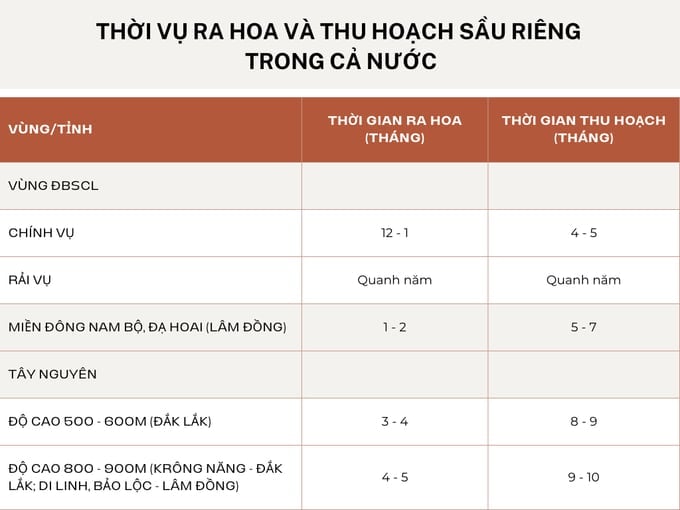
Flowering and harvesting seasons for different region in Vietnam. Photo: Kim Anh.
The durian harvesting season in the Central Highlands coincides with the durian harvesting season in southern Thailand. Unlike the Mekong River Delta, durian in the Southeast and Central Highlands flowers due to weather influence. Only a small number of durian farmers apply techniques to manage off-season flowering or staggered harvesting. As a result, the durian harvest season in these two areas can vary wildly depending on the annual weather factor. With the exception of the Mekong River Delta, where durian flowering can be managed year-round, Vietnamese durian has an extended harvesting season between April and October, with the off-season occurring between November and March of the following year.
In conclusion, Vietnam has formed four main durian production areas with varying natural conditions and climates, resulting in different harvesting periods, extending the durian harvesting season from April to October, in contrast to the previous window between April and June in the Mekong River Delta.
This diversity in harvesting seasons presents favorable conditions for Vietnamese durian to compete with other countries in the region. However, there will also be a degree of competitive dynamics between different Vietnam's regions. With the aim of achieving high efficiency, durian farmers must possess the knowledge of the differing local seasonal characteristics.
The Central Highlands, with vast land conditions and favorable climates, has become the largest durian production area in the country. The Mekong River Delta, with its advantage of water management and long-standing farming experience, especially during off-season production, can effectively compete during the off-season both domestically and internationally.
Translated by Nguyen Hai Long
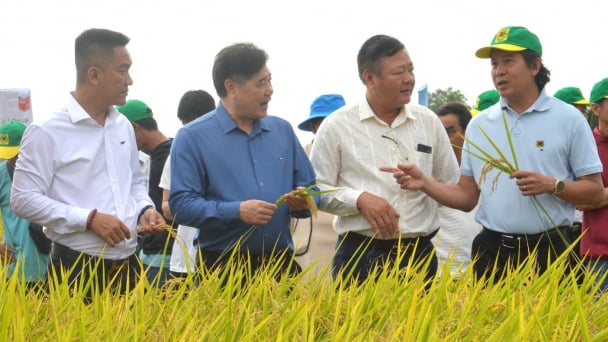
(VAN) The results from pilot fields are catalyzing the expansion of the One million hectares of high-quality, low-emission rice project in Kien Giang.
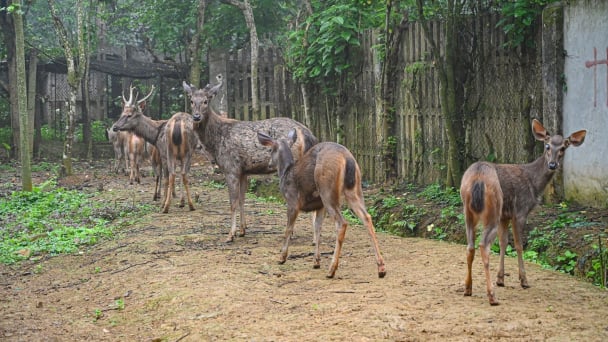
(VAN) On the morning of April 11, Cuc Phuong National Park received 18 individuals of endangered and rare wild animals from Da Nang city.
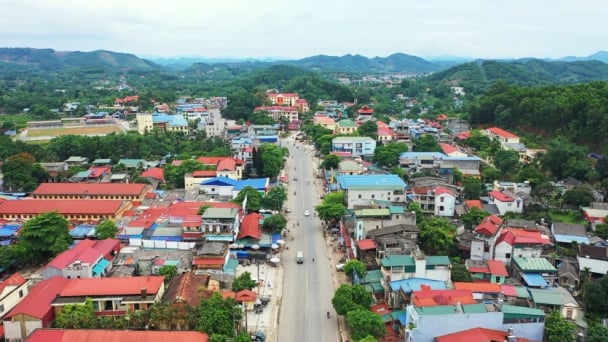
(VAN) FAO supports Vietnam in enhancing survey sampling techniques for the 2025 nationwide agricultural and rural census.
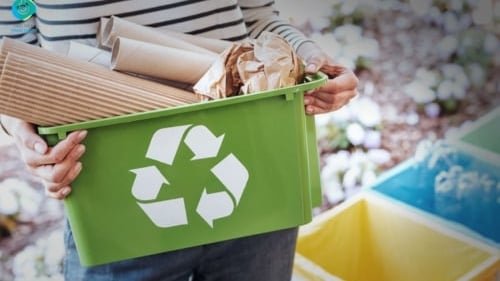
(VAN) By participating in the green transition, manufacturers become an indispensable part of the circular economy, contributing to resource optimization and environmental protection.

(VAN) The One Million Hectares of High-Quality and Low-Emission Rice Program can generate nearly 14 million tons of straw annually, posing an urgent requirement to diversify straw-based products.
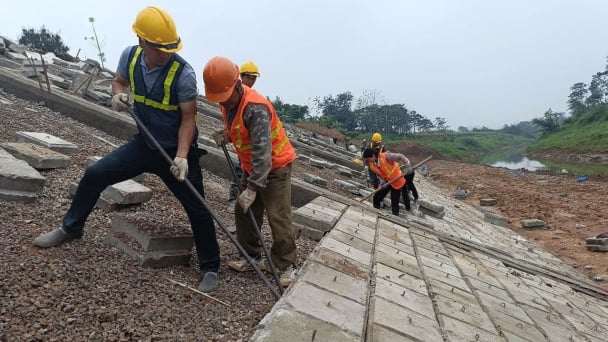
(VAN) This figure was recently announced at a conference held in Yen Bai, focusing on climate-resilient infrastructure development for ethnic minority regions.
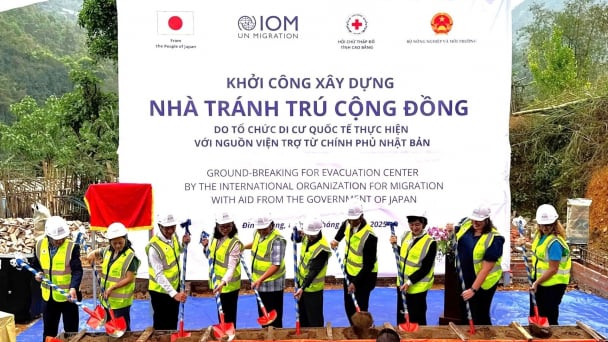
(VAN) The evacuation center is a practical work in efforts to respond to natural disasters and adapt to climate change in vulnerable areas.